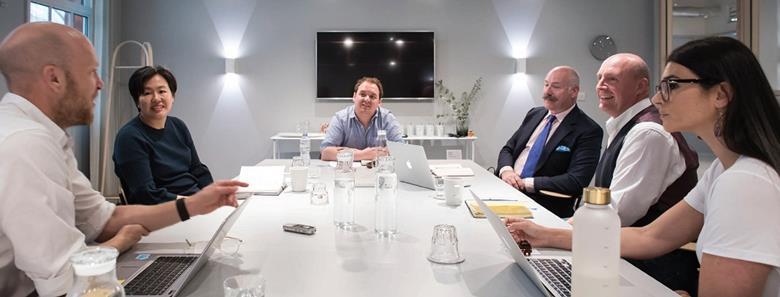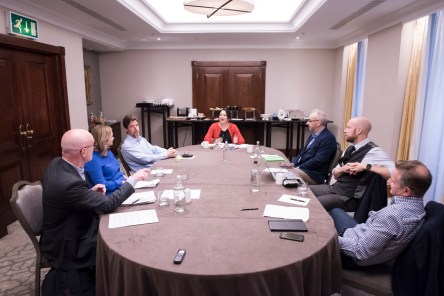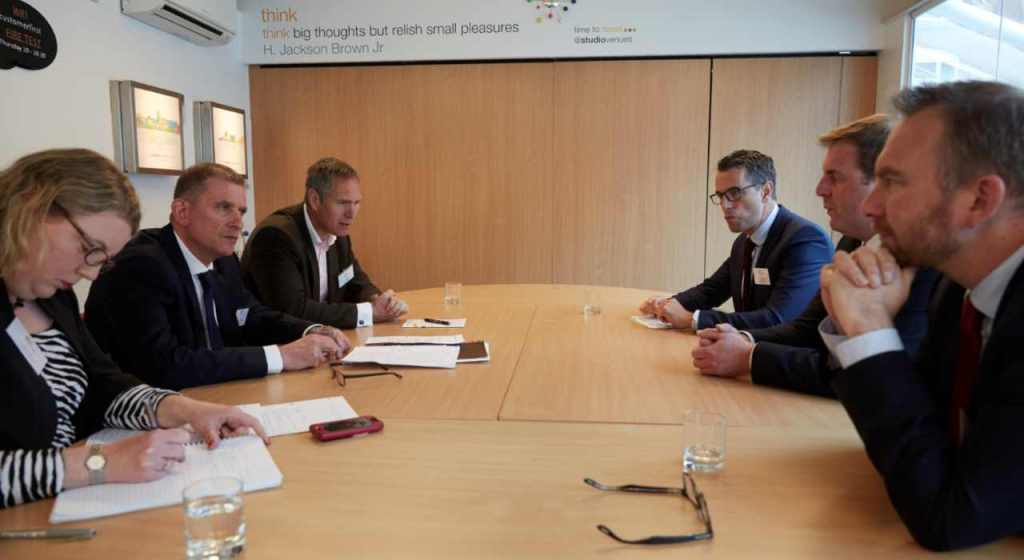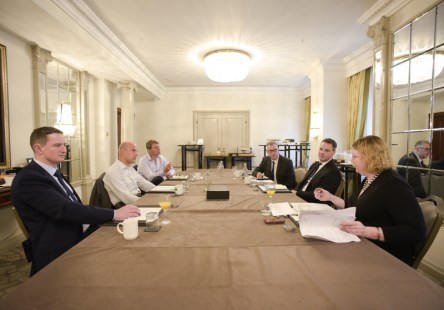Yardi’s vice president of international, Neal Gemassmer, recently spoke with the UK Proptech Association (UKPA) about the future of international proptech. Their conversation is reprinted below. Yardi started out as a small software start-up. Now, moving towards Yardi’s fourth decade, how have you seen technology evolve? Gemassmer: A lot has changed since 1984. Since then, Yardi’s technology road map has delivered consistent innovation as we remain focussed on meeting the evolving needs of the real estate industry, and helping our clients serve customers and improve business outcomes. As one of the earliest property management software start-ups, Yardi was founded on core property management and accounting. Since then, we have greatly expanded our range of products and services. Being one of the first real estate technology companies to transition to the cloud, our SaaS model has proven to be hugely successful. With a focus on mobility, connectivity and efficiency for users, we now provide a unique role-based ecosystem of solutions and interfaces for key positions in real estate management. Whether you’re an asset manager, investment manager, property manager or marketer, Yardi offers a range of solutions that are intentionally designed to connect teams across the entire real estate lifecycle, while leveraging a single source of data. Yardi now employs over 7,000 people worldwide and are active in over 80 countries, serving clients that invest in and operate a wide variety of real estate asset classes, from fund and asset management, commercial including office, industrial and retail, coworking and flexible workspace to residential including build to rent, PRS and student. Can you share any insights into the latest innovations at Yardi? What are you most excited about in the product pipeline? Gemassmer: We have creatively consolidated Yardi’s technology solutions into four main principles: Fully connected real estate management...
UKAA Expo 2020
Key Takeaways
It was great to see 400+ people representing the UK’s fast-growing build to rent sector last week at the UKAA Expo 2020; the third event of its kind hosted by The UKAA. Yardi was there in full force with a team of seven passionate residential specialists, all eager to learn, network and engage with the market. Early bird catches the reverse-trade show worm For many, the day started at 10am, but for the exhibitors and operators, it was an earlier start. A conventional tradeshow concept was flipped on its head at The Reverse Tradeshow, giving exhibitors the opportunity to attend 10-minute quickfire meetings with operators. It is great to see companies like EcoWorld, Folio London, Henley Investment Management, PLATFORM_ and Packaged Living investing time into further supporting the growth of the market. Networking and more networking It was all systems go when the doors opened at 10am. The exhibition was home to suppliers from all corners of residential real estate, including PropTech companies, law firms and regulatory organisations. Market Perspectives We were keen to ask other eventgoers how they found the day and get a perspective of their understanding of the market. Justin Harley, Regional Director at Yardi interviewed Lesley Roberts, President of the UKAA and Partner & Executive Director at Allsop, who advised BTR operators to be passionate about customer service, understand the market and find good suppliers. Justin also interviewed Paul Belson, PRS & BTR Investment Consultant who recognised the increase in PropTech innovation and The UKAA’s CEO, Dave Butler, who explained the key to success is to know your customer. Click on each image to watch the full interviews. Session Take-Aways Richard Lankshear, Innovation Manager of NHBC was first to take to stage where he gave some inspiring...
International Outlook...
Tech will dominate the decade
Editor’s note: the below perspective on 2020 and the decade ahead for technology and real estate comes from Neal Gemassmer, vice president of international for Yardi. Originally published in Property Week, it is reprinted here with permission. The festive period was an invitation to reflect on the year gone by and the year ahead, even more so than usual. After all, it was the end of one decade and the beginning of another. Naturally enough, all eyes are on Brexit, but from a real estate perspective the impact that technology is having on our industry offers the most interesting food for thought. New technology has had a greater impact on property in the last few years than in the previous three or four decades combined. In 2010, the term ‘proptech’ had not even been coined; today, it is ubiquitous. However, in my view we have barely scratched the surface in terms of its influence. In the years to come, it will redefine how real estate functions. Here are a few ideas as to how. First, consider the build-to-rent (BTR) market. More and more investors are moving into the sector and technology has the potential to act as a major enabler. Digital technologies can allow owners and operators to cut out the middle-man – the letting agent – and communicate directly with potential customers, who can view different buildings and get a feel for the quality of the accommodation and the amenities on offer. Virtual reality lets potential tenants view a property remotely, while online tools can arrange physical visits without the need to call or email ahead. Applications and background checks can also take place digitally and customers will be able to sign their lease and pay their deposit online. The whole process will become virtually...
Building a Flexible Brand
Yardi UK Think Tank
New Yardi UK roundtable discussion: With more property companies launching flexible workspace brands, Property Week and Yardi gathered a panel of industry experts to identify the secrets of success in a highly competitive market. Justin Harley (JH) – regional director, coworking, Yardi Maria Cheung (MC) – director and head of interior design, Squire & Partners Giles Fuchs (GF) – chief executive, Office Space in Town Alessa McNally (AM) – head of member’s experience, The Office Group John Williams (JW) – head of marketing, The Instant Group Simon Creasey (SC) – (moderator) contributing editor/features, Property Week What are the key components needed to create a successful flexible workspace brand? GF: Location, design, building layout, staff, culture, ethos, IT, consistency of customer service. You can go on forever making a list, but all of those things need to be a part of it. AM: Location is absolutely key. It’s definitely at the top of the list of things we look for when opening up a space. Also member experience. We are here to create a memorable experience for our members. JW: I agree, it’s all about the member experience. The conventional real estate market is still referring to the ‘occupier’ or the ‘tenant’. They’re thinking about looking after an asset and not providing an experience, which is what flexible workspace providers do so well. Once people experience the flexible workspace market I think it’s a shock when they go back to conventional office space because the level of service just isn’t there. What makes a great location for a flexible workspace centre? GF: We previously had a company that covered the whole of the UK and when we opened a property outside London one of my metrics was it had to be five minutes -walk from a Marks & Spencer. In London, our MO is that the location has to be within a four-minute walk – five minutes is probably okay – of a tube or rail hub. JW: I said two years ago that we were going to start to see the rise of second cities and coworking and flexible space becoming a story in the regions and I’m glad to say I was right. Demand for flexible workspace in cities like Bristol, Birmingham and Manchester is increasing by 25% to 30% every single year at the moment. Those secondary cities in the UK are really flying and we’re also seeing that in Europe and in the States. How important is design and fit-out to a flexible workspace brand? MC: It’s become massively important. It should have always been massively important, but the standards have been raised and everyone is really enjoying and realising the benefit of great design in the workspace. It’s no longer about sitting at a fixed desk. We are working in different ways. People want to be able to sit, to stand, to walk around and look at things. Design can enhance and allow different ways of working through the use of things like natural light, biophilia, control of the environment and even acoustics. JH: One of my favourite spaces in London is [flexible workspace provider] Uncommon. They have a lot of biophilia, but it’s the scent in their buildings that’s really beautiful. Smell is one of the most important senses. JW: I think there is a perception of how coworking and flexible space should look; it’s a bit like coworking design bingo. There should be exposed brickwork, free beer, lots of dogs and avocados on tap, but that’s not the case. There is a real individuality of different approaches and different spaces being provided. In the flexible workspace and coworking sector the word ‘community’ pops up time and time again. How important is it to create a sense of community in your flexible workspace? MC: When we created The Ministry [The Ministry of Sound’s private members club and coworking space] we worked closely with them...
Flexible Workspace
Topic of Yardi Think Tank
Yardi assembled a panel of flexible office experts to discuss the importance of a service ethos, how workspace providers can stand out from the competition and why the sector looks well placed to weather a possible recession. Panelists Gareth Evans, chief executive of BizSpace Katrina Larkin, co-founder of Fora Cal Lee, founder of WorkThere William Newton, president of Wiredscore Katie Whell, managing director at Pure Offices Tony Freeth, director of coworking at Yardi Simon Creasey, features editor at Property Week (chair) Flexible workspaces have been hailed as the future of offices, but as the business model continues to mature many questions arise about what this future might look like. To debate what lies ahead for flexible workspaces, Yardi put together a panel of some of the industry’s heavyweights. SC: How important is customer service for the coworking industry? GE: Customer service is what it’s all about. It’s quite interesting as a concept because one person’s customer service is another person’s lack of service. It depends on where you are regionally, what kind of centre you’re in and what people’s needs are. You can provide frothy coffee or whatever, but if that’s not what the customer wants then you’re not providing good customer service. KL: Myself and [Fora co-founder] Enrico [Sanna] come from a hospitality background, not from a workplace background. So, for us, customer service is absolutely key. We have worked with one of the top hospitality schools in Switzerland to attract the best people from the hospitality industry. WN: Before WiredScore moved into WeWork, we were with a provider who clearly hadn’t yet got what service meant. Their front of house people were security people trying to prevent people getting into the building who shouldn’t be there rather than welcoming in guests who...
Build to Rent Update
Yardi UK Think Tank
Yardi UK invited a team of northern property experts to The Slate Yard, a build-to-rent (BTR) development in Salford managed by urbanbubble, to discuss how the relatively nascent sector is evolving in the north of England and to explore the main obstacles that stand in the way of BTR’s future growth in the region. Participating in the discussion were: Michael Howard (MH), managing director, urbanbubble Matt Crompton (MC), joint managing director, Muse Developments Adam Higgins (AH), founder, Capital & Centric Shelagh McNerney (SM), head of development, Salford City Council Gavin Taylor (GT), regional general manager, Far East Consortium Simon Creasey, consulting editor (features), Property Week (chair) Where have we seen significant levels of BTR development take place in the north to date and why? MC: Manchester is streets ahead of other cities at the moment. I guess it comes down to the rental levels that you need to derive from occupiers and the void levels you can accommodate, which filters through the financial model to result in whether something is developable or not. The dynamics in Manchester work because you can see lots of activity happening here, but you don’t see as much activity happening in other strong northern cities – Liverpool, Leeds and the like. The same dynamic must exist in those cities in terms of agile workers that want to live there and have the flexibility of the BTR offer, but rents need to get to a level where developments become viable. SM: You can’t separate what’s going on in the housing market [in Greater Manchester] at the moment from all those large new employers coming into the city and I think that’s what distinguishes the area. While those other northern cities have got great assets and things to offer, it’s just the sheer...
Coworking Revolution
Becoming mainstream in UK
Increasingly, companies don’t have a five-or 10-year vision based around a particular space with a particular staff mix. They want short-term arrangements where they can flex their head count and floorspace up or down depending on need. This applies to businesses both large and small. While coworking once meant an office for four to six people, today deals are being signed for spaces that will accommodate 25, 50 or even 100 staff. Coworking also helps firms to retain the best employees by providing them with a stimulating and collaborative working environment. Sitting behind all of this is new technology which means that operating or using a coworking space is more streamlined than ever before. But with so many coworking spaces springing up, competition is getting ever more intense. So what can operators do to make their schemes are a success? Businesses today are looking for more than just a desk, a telephone and an internet connection – they want a level of service on a par with what you would expect in a high-end hotel. Years ago, we used to call the people sitting in the entrance ‘receptionists’, but today we refer to them as ‘front-of-house.’ In a successful coworking space they should engage with members, know them by name and be on hand to manage all aspects of the customer experience. Technology is a big part of this. A fast, reliable internet connection is crucial to most businesses and Yardi’s software means access to spaces is seamless, so when a member enters a coworking space they are instantly recognised and connected to the wifi. This can even work across multiple coworking locations. Unlike more traditional companies where most staff leave the building between 5pm and 6pm, some companies operating out of coworking spaces...
UK Think Tank
A Coworking Conversation
The evolution of the flexible office sector has shaken up the real estate industry and has arguably changed it for the better. Yardi recently brought together a panel of experts in the UK to discuss the many segments of flexible offices and what lies in store for the sector. Mary Finnigan, head of transactions, real estate, WeWork Chris Pieroni, operations director, Workspace Group Adrian Goldney, co-founder, Flexible Office Space John Williams, head of marketing, Instant Group Joff Sharpe, head of operations, British Land Tony Freeth, director coworking, Yardi Europe Liz Hamson, editor, Property Week – chair LH: With all the different definitions out there, what should we be calling the sector? Should there be a standard definition or does it really matter? CP: All the definitions out there are very different – hybrid, coworking, flexible, service – and then you’ve got all sorts of issues around whether they are an operator or a landlord and then you’ve got all sorts of issues about what sort of services are offered; whether they are exclusive or not. And it’s really complicated to pull all the data together and try to get an understanding. I’ve got my own view on where we stand in the flexible office market and we didn’t fit into any of the definitions. We’ve decided to just look at the flexible market. LH: So what do you define flexible as? CP: So we had three different categories – something under three months, and then we stopped at over 12 months. But actually, I think now as larger corporates want flexibility, you might be saying flexibility for them is three years. So I don’t know, but we stopped at over 12 months. JS: I don’t think the starting point is flexibility; it’s...
Flexible Workspace
Q&A with Tony Freeth
Editor’s note: The following interview originally appeared in GCUC UK and is reprinted with permission here. Tony Freeth has seen the evolution of the office space industry firsthand. Co-founder of Phoenix Broadband and creator of Medusa, a product that handles premises infrastructure, Freeth has played a pioneering role in bandwidth management and workspace wifi solutions since the late-1990s. Recently, Medusa was acquired by global real estate technology company Yardi. Freeth, who was at the first Global Coworking Unconference Conference (GCUC) in Austin, Texas in 2012, has now taken the role of Director of Coworking Europe at Yardi. With two decades of experience, Freeth provides a unique and valuable perspective on the now-booming workspace industry. We spoke with Freeth about the evolution of the industry, Yardi’s acquisition of Medusa, and how commercial real estate has now adopted coworking as an asset class. Here are the highlights of our conversation. What’s your coworking story, Tony? How were you introduced to what was then a small movement? Tony Freeth: In 2010, I was talking to someone at Steelcase who told me I needed to go to Coworking Europe. While there, I came across a bunch of people who had a very different idea of how people could work in a space, based on collaboration and community. We tried to sell that message to our conventional customers for many years, and for a long time their response was, “No that’s not what we do. Everyone wants a door.” We told them when you put millennials behind doors, it’s like depriving a plant of light—they just wilt. I met [GCUC producer] Liz Elam at Coworking Europe and she invited me to Austin for GCUC. It became clear that U.S. coworking seemed extremely vibrant and extremely well-organized. I imagine your...
Food Bank Fridays
Yardi UK Fights Hunger
Staff at the Yardi Milton Keynes office are cleaning out their home pantries. But they’re not checking for expiration dates—they’re collecting items for the Milton Keynes Food Bank. Located in Buckinghamshire, about an hour northwest of London, the Yardi UK office employs over sixty team members, and they hope to make a big impact. As part of Yardi’s philanthropy program, the UK team started a charity committee. They sent out a survey to gather feedback and decide which charities to support as a team. The group wanted to keep things local and at first chose a handful of organizations to contribute to. But after the initial charity drive, members of the team had a desire to get involved with something a bit more hands-on. Hannah Holmes and Martin Gedny from the marketing team took a trip to the local food bank. Both learned a great deal about the types of people who benefit from the organization. “It was such an insightful experience that we decided to get involved, and at the very least, set up a donation box,” said Hannah Holmes, marketing associate. “The collection has been a massive hit, and it’s just a start. We want to also encourage team members to get down there and volunteer as well,” said Martin Gedny, senior manager, EMEA marketing. The Milton Keynes Food Bank, recipient of the Queen’s Award for Voluntary Service, aims to educate locals about the realities of hunger in the area. Long believed to be an issue only in developing countries, hunger is a very real threat; even in prosperous communities, many families live on the edge of poverty. And since the food bank relies entirely on contributions from local schools, churches and businesses, every donation counts. Each week, the team checks the...
Build to Rent
Yardi UK Think Tank
Just a few years ago build-to-rent (BTR) was a rarely used phrase in the UK. Now it is one of the hottest real estate sectors around. A think tank of leading experts convened by Yardi and Property Week discuss the extent to which BTR has matured, the challenges it still faces and where the sector will go from here. The Think Tank Panelists: Andrew Cook – investment manager, M&G Real Estate (AC) Lora Salomidou – product owner, The Collective (LS) Rebecca Taylor – investment director, Long Harbour (RT) Katherine Rose – director of data & advisory services, Prsim (KR) John Dunkerley – chief executive and co-founder, Apache Capital (JD) Russell Markou – head of PRS operations,Tipi (RM) James Pargeter – projects director, Greystar Europe (JP) Chair: David Parsley – contributing editor, Property Week (DP) DP: How far along is BTR to becoming a mature market and is it now considered an institutional-grade investment? JD: There’s a big difference in people’s perception of where they think it is and where it actually is. There are 110,000 BTR units under construction or in planning. I don’t think we’re really scratching the surface yet. I don’t think it’s as advanced as people think it is. LS: The Collective has come from a slightly different angle to BTR and is focusing more on the consumer. The main reason we have got to where we are with BTR is because there has been a fundamental change in the expectations of consumers. The investors’ point of view is slightly different, but if we compare the return on investment from BTR to build-to-sell it is very different, because investors don’t have to manage the property – companies like us do it. JP: It’s certainly not yet mature in terms of finished...
Great Expectations
UK Retail Real Estate
LONDON – The evolution of the retail store in the face of growing online sales has been much written about, but shopping centres also can’t afford to be left behind in the age of ecommerce and changing technologies. This Retail Week report – produced in association with Yardi – explores how retailers view shopping centres and ways that centres can create an environment in which retail doors not only remain open, but thrive in a digital era. Based on interviews with 50 retail directors responsible for store portfolios – each representing a company with a turnover of between £50m and £10bn – the report finds strong similarities in what retailers want from shopping centres, and reflects changing shopper habits. Key themes are explored around how shopping centres can better support retailers, including expectations about infrastructure for technology and data, as well as how they can attract new entrants. The right mix between retail, leisure and dining is a fundamental attraction, while providing wi-fi is a prerequisite for retailers setting up shop in malls, which has both customer-facing and operational benefits. The future opportunities for shopping centres to enhance their performance, while diverse, are all underpinned by robust data. Decisions are increasingly data-led, and while current platforms – typically management software and spreadsheets – for data sharing have been well-received by retailers, there’s a strong feeling centre owners could provide more information. In particular, they want detail about footfall, dwell time and average spend, to better understand the local catchment and to adapt store space accordingly. Common themes for shopping centre investment over the next 12 months, according to our surveyed retailers, include keeping up with new technology, integrating ecommerce and opening new stores – all of which are elements that new entrants such as...
Managing Risk
UK Investment Think Tank
Yardi and Property Week assembled five property investment experts to discuss low-risk ways to find value amid fierce competition for prime property. Industrial, traditional PRS, build to rent and student housing were seen to offer opportunities, with a tough retail climate and political risk on the downside. Panelists Ian Benson: Finance Director, Kier Property Meg Brown: Director of equity placement, Colliers Howard Freedman, Partner/head of real estate and construction, RSM Jamie McCombe, Partner/head of IM, Cluttons Kris McPhail, Co-fund manager, Lime Property Fund, Aviva Moderator: David Parsley, Property Week contributing editor With prime property yields tightening and investors looking for value without too much risk, our think tank participants addressed the key issues of where funds should place their cash and what factors – both positive and negative – may affect their decisions and returns. Where are the hot sectors in real estate investment? MB: This is something we think about a lot, as we typically advise pension funds and groups where risk really matters, as they are investing money they can’t really lose. So right now we’re fans of things that are not correlated to economic cycles, and that’s largely mega-themes such as student housing, PRS and BTR, micro living and, to some degree, the co-working concept. JM: We feel capital growth is going to be more muted in this market, so there has been a flight to income return. We’ve been looking at some of those long-term income plays, such as hotels and student accommodation. The industrial sector has obviously been improving in the past 12 months, predicated on investors seeing some future rental growth, so yields have fallen quite significantly, but in the right areas and at right rent, there is still something to go for in terms of return. The prime end of the...
UK Perspective
Better build-to-rent marketing
The UK’s build-to-rent sector is booming. In less than a decade, the sector has grown by around 60% and is now worth some £1.5trn. This comes as no surprise. We all have, at some point in our lives, been looking for a place to live, whether it is a house or a flat, and build-to-rent is an alleviation in the midst of the UK’s housing crisis. The internet has made home searching extremely easy and the advent of the so-called ‘generation rent’ has seen millions of people turning to renting as their model of choice. The old days of pen and paper, endless phone calls and long rides in your car to view properties are long gone and the search is now almost entirely conducted on the web. Just as shopping no longer means showing up in a store, home searching has become essentially digital. But even so, the process might be extremely slow. Imagine you are on your lunch break, looking for an apartment on your laptop or smartphone. You are clicking on dozens of different sites, scrolling through pages and pages of dubious websites. Maybe the information provided on the website is incomplete. It lacks floorplans and energy ratings. There are no reviews or pictures. How can you trust this website instead of another one? Is the apartment going to be as good as it is presented? Are you just going to waste your time? Hunting for an apartment can be a very frustrating experience indeed. Turning to the other side, and looking at the situation from a landlord’s perspective, it is increasingly hard to catch a home-hunter’s attention. Due to the same chaotic web scenario, this challenge is now tougher than ever. How can a landlord make a prospective resident discover...
Build to Rent
Responding to Proptech
LONDON – Technology has changed all our lives so fundamentally in recent years that it is sometimes difficult to look back to an era when things were done differently. Today’s normality was, just a short time ago, unthinkable. Banking is a good example. Today, we take it for granted that we can access our accounts at any time and transfer money and pay bills quickly and cheaply. The chequebook is still available for those who need it, but it won’t be long before they too are consigned to history. Then take taxis. While in London at least, using a cab was once the preserve of those with substantial salaries – or travelling at somebody else’s expense – now the rise of Uber and others means that getting a ride home is a real option for many people. Property has, of course, been slow to embrace the benefits that digital technology can bring – one estimate is that the industry is around 20 years behind financial services – but that is starting to change and at pace. Just a few years ago, if the property press mentioned technology at all, it was to reference the influence of the likes of Rightmove or Zoopla. Today the phenomenon has its own name: proptech. A lot of attention has been paid to how proptech is disrupting the industry, most notably through big data potentially making the role played by many agents redundant. That is obviously a cause for concern and the introduction of new ways of working will obviously have to be done with care and compassion. But proptech also has the potential to bring huge benefits to both property companies and their consumers – and without the need for anyone to lose their jobs. In no sector...
UK Honor
Software Provider of the Year
Yardi, a global provider of real estate technology, was proud to accept the Property Management Software Provider of the Year award at the recent Property Week All-Star Management Awards, which took place at the Grosvenor Hotel in London on the 3rd of November. The Property Week Management All-Stars Awards are held annually and celebrate excellence across all segments of the management of real estate – from AST and block residential, multi-occupier office and retail, to industrial and logistics. Property Week is the leading news magazine in the commercial and residential property market. Packed with news, features, opinion and analysis, Property Week keeps readers fully briefed on all the latest information from the industry, including major property deals, development opportunities and investment prospects. Martin Betts, Yardi sales director for the UK & Ireland, was on hand to collect the award recognising the company as Property Management Software Provider of the Year. “We are thrilled to have won this award and believe it reflects our continued commitment to providing innovative solutions focused on enhancing the customer experience and optimizing our clients front and back-office operations,” said Neal Gemassmer, vice president, international for Yardi. “We continue to actively invest in growing the suite of solutions that we provide to the rapidly growing residential ‘build to rent’ sector, as well as staying focused on investment, asset and property management solutions for the commercial market.” Yardi would also like to congratulate several clients that received awards during the evening, including LIV Group, awarded the BTR/PRS Operator of the Year, and GVA, which was named Property Financial Advisory of the...
Retail Management
Keys to a Successful Portfolio
As modern landlords strive to drive footfall and revenues in their shopping centers, they are using sophisticated new tools and techniques. Astute use of data can lead to better-informed decisions – but how is the impact of this new discipline being felt across the property industry? Yardi brought together a panel of thought leaders in the sector in a round table event in central London. Fiona Hamilton, global head of retail for international brands, BNP Paribas Allan Lockhart, property director, NewRiver REIT Charles Maudsley, executive director, head of retail, British Land Sophie Ross, group head of multichannel, Hammerson Ailish Christian-West, head of portfolio, shopping centers, Landsec Claer Barrett, personal finance editor, Financial Times (chair) How widespread is the use of data becoming within physical retail assets? SR: It’s relatively easy to capture data – it’s much harder to add value. I would say that only around 20 percent of the data gathered by landlords is being used effectively. CM: Data is just the starting point. At British Land we collect and analyze more data than ever before about shopping patterns, demographics and spending. We replay that to retailers. Anonymised mobile phone signals can show us a heat map of where shoppers are in the center, and point to linkages between retailers. For example, our brand profiling shows TK Maxx and Pret a Manger are highly correlated. TK Maxx in Hinckley – would an adjoining Pret boost their sales? We can measure conversion rates – the number of people who pass a store versus the number who actually go in. We can say to a retailer, it’s 30 percent in your shop, but it’s 90 percent elsewhere, so let’s find out why. We can show retailers looking to open a store with us how their...
Tech + Logistics
Great Britain Automation Outlook
The rise of ecommerce has revolutionised the way we shop – but it has also transformed property logistics. Technology is helping retailers and carriers to manage stock movements, in-store click & collect and home deliveries, but it is also a costly investment. Who will pick up the tab? How are developers, investors, distributors and occupiers using ‘smart logistics’ to serve their customers? Yardi brought together a panel of thought leaders in a roundtable at Property Week’s Sheds Conference in Birmingham. The panel: Paul Crosbie, investment manager, M&G Real Estate Jonathan Gardner, head of asset management, Delin Capital Nick Kay, development director, St Modwen Properties Len Rosso, head of industrial and logistics, Colliers International Charles Spicer, Midlands industrial and logistics director, Savills Claer Barrett, personal finance editor, Financial Times (chair) CB: What do you all think the ‘shed of the future’ will look like? How will the needs of occupiers change over the next five years? LR: I don’t think we should call logistics space ‘sheds’ anymore. It is a much more technologically advanced product than the name suggests. Drones, robots and automation are all on the horizon, but I think the biggest change we’re seeing right now is higher eaves heights and mezzanine floors. Occupiers want to use all the space they’re paying for – not just the ground floor. PC: People are getting very excited about drone deliveries, but they are more likely to be used for rural areas rather than built-up urban locations where their use will be more restricted. JG: Occupiers will still be using vans and lorries, charge can bypass the 200-mile mark, it will really make a change to the use of this technology. NK: And look at the activity going on inside the shed. The rise of the ‘sharing economy’ is a big trend. We’ve seen Airbnb; now there’s a similar business called ZupplyChain for third- party logistics [3PL] companies with excess space to lease it out. If you can find space in areas of undersupply, it would make the market more fluid and ease the supply crunch. CS: The shed of the future won’t be one size fits all. Our market is very varied and diverse – so a manufacturer’s requirements are very different to that of a pure logistics operator. That said, we’re already seeing multi-level facilities and in the future we could well see subterranean ‘sheds’ in high-density urban areas. At the Property Week Sheds Conference, we’ve just heard a number of occupiers say they would not be averse to the idea of sharing space in the future so I anticipate more multi-user facilities as is commonplace in mainland Europe. There are covenant and lease issues but nothing that is insurmountable. We may see a company that is institutionally acceptable taking a ‘master lease’ and then space split between multiple users and companies in a Regus-type model. CB: As investors, how happy would you be with the idea of a shared shed? PC: A facility shared by a number of operators would be interesting if there was an overriding lease. It could give investors more comfort if there was some diversity alongside the main tenant. LR: DHL has been talking about that model for the past five years, but it hasn’t happened yet. JG: Well, it has happened in mainland Europe. 3PLs want to match their lease lengths with their contract terms. If they have a three-year contract, they don’t want to take a five-year lease. However, this comes at a cost – they accept they will have to pay a much higher rent in some locations. Other 3PLs will take a big lease and will stack the space with three or four different customers’ kit. Even then, there could be quite tough conditions to meet, such as 50% of the space being occupied by one client for the full length of the lease. PC: I agree that the sheds –...
NewRiver REIT
UK client interview
The British retail investment market joins the rest of the United Kingdom’s business community in facing a host of unknowns in 2017. Chief among them is the timing and impact of the UK’s exit from the European Union following the outcome of the referendum in June 2016. Yardi caught up with one its partners, NewRiver REIT, a specialist retail and leisure investor, asset manager and developer whose convenience-led positioning means it is uniquely placed to navigate these uncertain times. NewRiver’s £1.3 billion portfolio includes 33 community shopping centres, 22 retail parks, 16 high street assets and 350 pubs. The portfolio provides consumers up and down the UK with its daily essentials – those items essential to daily life, the things consumers require, opposed to what they simply desire. Fundamental to the success of the business over the past seven and half years has been how NewRiver has engaged with and satisfied all the stakeholders within its chain, from store customers, retailers, peers, advisors and local authorities all the way to its institutional investors and shareholders. “At the heart of the retail sector is the customer and our business begins with building and retaining consumer loyalty,” says Emma Mackenzie, a Director at NewRiver who manages assets in Scotland, Northern Ireland and the north-east of England. “At the local level, we make sure our shopping centres satisfy the needs of the towns they serve. Its about providing a variety of products and services at a price the customer can afford. Furthermore, we work hard to ensure the environment is fit for purpose – and that includes such basic factors as the centre being clean and accessible as well as bright and attractive and providing somewhere to sit down or get a cup of tea.” Brexit has triggered...
Build-to-Rent
UK Real Estate Evolves
GREAT BRITAIN (March, 2017) – It is no longer about landlords; today’s property managers recognise that happy residents are at the heart of any successful scheme. Yardi invited a panel of experts in Leeds – a ‘northern powerhouse’ city heavily invested in cutting edge build-to-rent development – to discuss the rapidly-evolving sector Graham Bates – Founder and chief executive – LIV Group Jonathan Pitt – National director, corporate PRS and build-to-rent, Countrywide Joanne Pollard – Director – Five Nine Living, Fresh Student Living Andrew Wells – Partner and non-executive chairman – Allsop Letting & Management (Interviewer) Claer Barrett – Personal finance editor – Financial Times (chair) What is the biggest challenge for the build-to-rent sector? Joanne: There are three main challenges. Firstly, there’s not enough stock. Everyone wants to pile in from an investment perspective – and if you want to buy assets producing rents, that’s a challenge. Secondly, we’re all learning about this together. There are new practices and we need to find the best ones. And finally, costs. How much of a premium are people prepared to pay? Jonathan: I agree – the big challenge is where the private rented sector (PRS) sits in the market. What is the premium people will pay to live in a well-run building with amenities? And what about mid-market level? Graham: PRS is not the right label. What we do is build-to-rent. The private rented sector as a whole includes buy-to-let. We are a segment of PRS but what makes us different is that we are building for long-term rental. We are starting to see what I call ‘live learning’. As this sector started to take off, people talked about what might happen. Now we’ve got people living in buildings. We have data. We can conduct...
Focus on Manchester
UK Think Tank
UK Think Tank: Insight from a recent real estate roundtable held in coordination with Property Week. Manchester is one of the UK’s most successful locations for large-scale private rented sector projects. But what are the drivers of success? Yardi brought together a think tank to discuss future developments in the sector. OUR PANEL OF EXPERTS Tom Bloxham MBE – founder, Urban Splash Matthew Howard – deputy fund manager, Hermes Real Estate Investment Management Antonio Marin-Bataller – investment executive, PATRIZIA UK Stefan Trebicki – project architect, SimpsonHaugh Paul Winstanley – partner and analyst, Allsop’s private rented sector and build-to-rent team Oliver Wolfryd – operations manager, Moda Living Claer Barrett – personal finance editor, Financial Times, and contributing editor, Property Week (chair) Why have you all chosen to invest and develop build-to-rent (BTR)schemes in Manchester? Antonio: Manchester scores highly from a demographic point of view, and the high level of interest from institutional investors makes the city a compelling story. The choice of city centre sites was relatively ample and it’s a very walkable city. Young people want to be in walking distance of transport, work, entertainment and friends, and Manchester has one of the highest retention rates for students following graduation in the UK. Matthew: Manchester was an obvious choice for us – it has all the drivers of urbanisation and the city centre has undergone a renaissance. Tom: When I first came to Manchester years ago, there were 200 people living in the city centre and you couldn’t buy a pint of milk. Now 30,000 live here, and I believe it’s only just started – there will be a lot more growth. BTR is very popular here – is Manchester going to have an oversupply problem? Tom: What I do worry about is that...
Value Opportunity
For British Shopping Centres
Editor’s note: the following article originally appeared in the British real estate publication Property Week on Nov. 25. Martin Betts is Yardi’s Sales Director for UK and Ireland. Are some shopping centre landlords guilty of thinking their asset is simply a property? They get the tenants in, the leases agreed and the rents start rolling in. But thinking in this way can limit the potential of the asset. For unlike an office block or an industrial unit, the shopping centre presents many different avenues for turning revenue. The unique nature of the mall means there is huge potential for additional revenue generation- something landlords and shopping centre managers need to ensure are managed and promoted effectively. Spaces like the walls are potential advertising spots, mobile phone masts can be erected on top of the buildings, pop-up stands can be used to utilise what would otherwise be dead space within the mall and even car washing facilities in the car park – all of this generates rent for the landlord and maximises space. Some of the best shopping centre operators have been doing this for years, but there are still way too many that aren’t or are not capturing the data that highlights where these opportunities exist. The UK market is moving more and more to a turnover rental structure, so an even greater prevalence is put on the landlord to drive footfall and entice people to the centre. But this is not easy in such a competitive retail and shopping centre sector, where you may have three shopping centres in close proximity to one another, all vying for the same customers. People will generally choose on the calibre of the shops and the experience they receive. So how do successful landlords and managers attract...
British Mixed-Use
Yardi Real Estate Think Tank
Editor’s Note: As part of a recurring series in partnership with Property Week, Yardi hosts Think Tanks on real estate development trends in Great Britain. Recently, Yardi brought together a panel of experts to discuss future developments in mixed use, a concept that is gaining traction in the region. The Panelists: Victor Nicholls Assistant Chief Executive – Bracknell Forest Council Michael Auger Regional Director, South – Muse Developments Alistair Shaw Managing Director (TV Centre) – Stanhope Ben Giddens Executive Director – Development – Quintain Alan Harris Partner – Montagu Evans Claer Barrett Personal Finance Editor – Financial Times (chair) CB: Let’s begin by debating what have been the biggest changes to mixed-use over the past decade. BG: The biggest change was the last recession and what that meant for development sites. With the residential tap turned off, you had to look to other uses to bring schemes forward. MA: Mixed-use is the new normal. The biggest change has been the perceptions of funders and occupiers. Ten years ago, they might have felt a mixed-use scheme was ‘pushing the boundaries’ and it was hard work to convince funders in particular that a scheme was going to succeed. Now, they actually want to invest in mixed-use schemes – that’s a fundamental shift. VN: [There is more] enthusiasm from local authorities towards mixed-use, and much more flexibility. Yes, we like our zoning and masterplanning, but that comes from the pressure we’re under to deliver housebuilding targets. But I definitely see more flexibility in the public sector. BG: We have flexible planning consent on several plots of land at Wembley Park where we have outline consent from the local authority to develop offices, residential, hotel space or student accommodation above ground-floor retail. This allows us to respond...
Yardi Think Tank
London's apartment market
LONDON – The burgeoning demand for rental property – particularly in London – means developers of build-to-rent schemes have a captive market, but everything else from valuation to finance and planning seems to be stacked against the sector significantly expanding. What do the pioneers of this form of development have to tell us about the state of the UK housing market and housing policy, and how are they overcoming the odds to deliver profitable schemes? Panel participants: Claer Barrett, Financial Times – Chair Dominic Martin, Operations & Strategy –Westrock Neil Young, Chief Executive – Get Living London Ryan Prince, Chief Executive and Co-Founder– Realstar Living James Scott, Chief Operating Officer –The Collective CB: There has been a lot of noise about ‘build to rent’ as a policy, but correspondingly little development in the private rented sector (PRS). Why is it so challenging financially? RP: It is uneconomic for PRS developers to compete with housebuilders. By our estimates, they can pay 30% more for a site. Then there is the time it takes persuading the planners. When you actually do the math, taking planning, construction, leasing risk and time into account, returns can actually be pretty poor. Most new PRS schemes are either government-procured PRS, where land is marketed on the basis that it will be PRS instead of homes for sale, or part of large-scale regeneration projects. If you remove those specific circumstances, you have no real meaningful, scalable policy framework to have a PRS industry in the UK. I think it gets disproportionate headlines relative to its size. DM: We still do not have clarity for PRS in the planning process. The London mayor’s supplementary planning document is starting to go in our direction, but it is still only guidance. Local authorities can do...
























